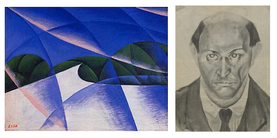Synaesthesia and the Great War
By Andrew Choi '13 on February 16, 2012 11:23 AM

"Today's dissonance in music and painting is merely the consonance of tomorrow," wrote Russian painter Wassily Kandinsky in a 1913 letter to Austrian composer Arnold Schoenberg. At the dawn of the 20th century, artists like Kandinsky and Schoenberg broke free from the norms of their medium--and subsequently, their era--by creating music and art that was atonal and abstract. But one year later, the entire movement was uprooted, and the daring avant-garde was replaced by the traditionalism of yesteryear.
What explains this artistic retreat? The Great War, according to author and musicologist Olivia Mattis, who visited campus Saturday as part of ROMP (Reediana Omnibus Musica Philosopha), Reed's annual symposium on music and the liberal arts. "The high modernism of the pre-World War I avant-garde was displaced" after the war, said Mattis. "War called for a return to traditional values."
Mattis used the work of composers and artists to show how WWI led to a singular, paradigmatic shift. Before the war, music and visual art reflected a mood that was ambitious and emboldened by the promise of the future. Paintings such as futurist Giacomo Bella's Abstract Speed + Sound (1913, above left) and Schoenberg's "musical self-portrait" Pierrot Lunaire were meant to serve as abstruse, yet optimistic, appeals to the artistic and technological unknown of the future. Soon, however, the horror and devastation of the war induced a 180-degree shift in artistic norms: the abstruse became the obtuse, and the promise and consonance of the future devolved into the disillusionment and dissonance of today. Artists now wanted the world behind them instead of the one in front of them. To illustrate this, Mattis pointed to works such as the Schoenberg's self-portrait (above right), as well as French composer Maurice Ravel's Trio: traditional artistic representations that served as a "call to order."
WWI also had the uncanny effect of unifying visual art, poetry, and music, triggering a collective bout of artistic "synaesthesia," said Mattis, in which perceptions are translated into different sensory modalities: color becomes sound, touch is transmuted into taste, and so on. The end result was, apparently, a united artistic sensibility dynamically pulsating throughout Europe in first two decades of the 20th century; a synaesthetic synthesis that reflected first the optimism of the modern age, and later its chaos.
Tags:
art, chaos, modernism, music, ROMP




LATEST COMMENTS
steve-jobs-1976 I knew Steve Jobs when he was on the second floor of Quincy. (Fall...
Utnapishtim - 2 weeks ago
Prof. Mason Drukman [political science 1964–70] This is gold, pure gold. God bless, Prof. Drukman.
puredog - 1 month ago
virginia-davis-1965 Such a good friend & compatriot in the day of Satyricon...
czarchasm - 4 months ago
John Peara Baba 1990 John died of a broken heart from losing his mom and then his...
kodachrome - 7 months ago
Carol Sawyer 1962 Who wrote this obit? I'm writing something about Carol Sawyer...
MsLaurie Pepper - 8 months ago
William W. Wissman MAT 1969 ...and THREE sisters. Sabra, the oldest, Mary, the middle, and...
riclf - 10 months ago